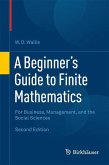Schade – dieser Artikel ist leider ausverkauft. Sobald wir wissen, ob und wann der Artikel wieder verfügbar ist, informieren wir Sie an dieser Stelle.
- Gebundenes Buch
- Merkliste
- Auf die Merkliste
- Bewerten Bewerten
- Teilen
- Produkt teilen
- Produkterinnerung
- Produkterinnerung
Now in its tenth edition, this text once again lives up to its reputation as a clearly written, comprehensive finite mathematics book. In an engaging and accessible style, this book demonstrates how mathematics applies to various fields of study.
Andere Kunden interessierten sich auch für
![A Beginner's Guide to Finite Mathematics A Beginner's Guide to Finite Mathematics]() W. D. WallisA Beginner's Guide to Finite Mathematics52,99 €
W. D. WallisA Beginner's Guide to Finite Mathematics52,99 €![Introduction to the Explicit Finite Element Method for Nonlinear Transient Dynamics Introduction to the Explicit Finite Element Method for Nonlinear Transient Dynamics]() Shen R WuIntroduction to the Explicit Finite Element Method for Nonlinear Transient Dynamics154,99 €
Shen R WuIntroduction to the Explicit Finite Element Method for Nonlinear Transient Dynamics154,99 €![Finite Element Method in Manufacturing Processes Finite Element Method in Manufacturing Processes]() Finite Element Method in Manufacturing Processes183,99 €
Finite Element Method in Manufacturing Processes183,99 €![Internal Logic Internal Logic]() Y. GauthierInternal Logic77,99 €
Y. GauthierInternal Logic77,99 €![A Set Theory Workbook A Set Theory Workbook]() Iain AdamsonA Set Theory Workbook39,99 €
Iain AdamsonA Set Theory Workbook39,99 €![Mathematical Theory of Finite and Boundary Element Methods Mathematical Theory of Finite and Boundary Element Methods]() SchatzMathematical Theory of Finite and Boundary Element Methods35,99 €
SchatzMathematical Theory of Finite and Boundary Element Methods35,99 €![Internal Logic Internal Logic]() Y. GauthierInternal Logic75,99 €
Y. GauthierInternal Logic75,99 €-
-
Now in its tenth edition, this text once again lives up to its reputation as a clearly written, comprehensive finite mathematics book. In an engaging and accessible style, this book demonstrates how mathematics applies to various fields of study.
Produktdetails
- Produktdetails
- Verlag: John Wiley & Sons
- 10th edition
- Erscheinungstermin: 1. November 2007
- Englisch
- Abmessung: 272mm x 213mm x 57mm
- Gewicht: 2508g
- ISBN-13: 9780470287545
- ISBN-10: 0470287543
- Artikelnr.: 23410384
- Herstellerkennzeichnung
- Libri GmbH
- Europaallee 1
- 36244 Bad Hersfeld
- gpsr@libri.de
- Verlag: John Wiley & Sons
- 10th edition
- Erscheinungstermin: 1. November 2007
- Englisch
- Abmessung: 272mm x 213mm x 57mm
- Gewicht: 2508g
- ISBN-13: 9780470287545
- ISBN-10: 0470287543
- Artikelnr.: 23410384
- Herstellerkennzeichnung
- Libri GmbH
- Europaallee 1
- 36244 Bad Hersfeld
- gpsr@libri.de
Chapter 1: Linear Equations.
1.1. Lines.
1.2. Pairs of Lines.
1.3. Applications to Business and Economics.
1.4. Scatter Diagrams; Linear Curve Fitting.
Chapter Review.
Chapter Project.
Chapter 2: Systems of Linear Equations.
2.1 Systems of Linear Equations: Substitution; Elimination.
2.2 Systems of Linear Equations: Gauss-Jordan Method.
2.3 Systems of m Linear Equations Containing n Variables.
Chapter Review.
Chapter Project.
Chapter 3: Matrices.
3.1 Matrix Algebra.
3.2 Multiplication of Matrices.
3.3 The Inverse of a Matrix.
3.4 Applications in Economics (the Leontief Model), Accounting, and
Statistics (the Method of Least Squares).
Chapter Review.
Chapter Project.
Chapter 4: Linear Programming with Two Variables.
4.1 Systems of Linear Inequalities.
4.2 A Geometric Approach to Linear Programming Problems.
Chapter Review.
Chapter Project.
Chapter 5: Linear Programming: Simplex Method.
5.1 The Simplex Tableau; Pivoting.
5.2 The Simplex Method; Solving Maximum Problems in Standard Form.
5.3 Solving Minimum Problems Using the Daily Principle.
5.4 The Simplex Method for Problems Not in Standard Form.
Chapter Review.
Chapter Project.
Chapter 6: Finance.
6.1 Interest.
6.2 Compound Interest.
6.3 Annuities; Sinking Funds.
6.4 Present Value of an Annuity; Amortization.
6.5 Annuities and Amortization Using Recursive Sequences.
Chapter Review.
Chapter Project.
Chapter 7: Probability.
7.1 Sets.
7.2 The Number of Elements in a Set.
7.3 The Multiplication Principle.
7.4 Sample Spaces and the Assignment of Probabilities.
7.5 Properties of the Probability of an Event.
7.6 Expected Value.
Chapter Review.
Chapter Project.
Chapter 8: Bayes' Theorem; The Binomial Probability Model.
8.1 Conditional Probability.
8.2 Independent Events.
8.3 Bayes' Theorem.
8.4 Permutations.
8.5 Combinations.
8.6 The Binomial Probability Model.
Chapter Review.
Chapter Project.
Chapter 9: Statistics.
9.1 Introduction to Statistics: Data and Sampling.
9.2 Representing Qualitative Data Graphically: Bar Graphs; Pie Charts.
9.3 Organizing and Displaying Quantitative Data.
9.4 Measures of Central Tendency.
9.5 Measures of Dispersion.
9.6 The Normal Distribution.
Chapter Review.
Chapter Project.
Chapter 10: Markov Chains; Games.
10.1 Markov Chains and Transition Matrices.
10.2 Regular Markov Chains.
10.3 Absorbing Markov Chains.
10.4 Two-Person Games.
10.5 Mixed Strategies.
10.6 Optimal Strategy in Two-Person Zero-Sum Games with 2 X 2 Matrices.
Chapter Review.
Chapter Project.
Chapter 11: Logic.
11.1 Propositions.
11.2 Truth Tables.
11.3 Implications; The Biconditional Connective; Tautologies.
11.4 Arguments.
11.5 Logic Circuits.
Chapter Review.
Chapter Project.
Appendix A: Review.
A.1 Real Numbers.
A.2 Algebra Essentials.
A.3 Exponents and Logarithms.
A.4 Recursive Defined Sequences: Geometric Sequences.
Appendix B: Using LINDO to Solve Linear Programming Problems.
Appendix C: Graphing Utilities.
C.1 The Viewing Rectangle.
C.2 Using a Graphing Utility to Graph Equations.
C.3 Square Screens.
C.4 Using a Graphing Utility to Graph Inequalities.
Answers to Odd-Numbered Problems.
Photo Credits.
Index.
1.1. Lines.
1.2. Pairs of Lines.
1.3. Applications to Business and Economics.
1.4. Scatter Diagrams; Linear Curve Fitting.
Chapter Review.
Chapter Project.
Chapter 2: Systems of Linear Equations.
2.1 Systems of Linear Equations: Substitution; Elimination.
2.2 Systems of Linear Equations: Gauss-Jordan Method.
2.3 Systems of m Linear Equations Containing n Variables.
Chapter Review.
Chapter Project.
Chapter 3: Matrices.
3.1 Matrix Algebra.
3.2 Multiplication of Matrices.
3.3 The Inverse of a Matrix.
3.4 Applications in Economics (the Leontief Model), Accounting, and
Statistics (the Method of Least Squares).
Chapter Review.
Chapter Project.
Chapter 4: Linear Programming with Two Variables.
4.1 Systems of Linear Inequalities.
4.2 A Geometric Approach to Linear Programming Problems.
Chapter Review.
Chapter Project.
Chapter 5: Linear Programming: Simplex Method.
5.1 The Simplex Tableau; Pivoting.
5.2 The Simplex Method; Solving Maximum Problems in Standard Form.
5.3 Solving Minimum Problems Using the Daily Principle.
5.4 The Simplex Method for Problems Not in Standard Form.
Chapter Review.
Chapter Project.
Chapter 6: Finance.
6.1 Interest.
6.2 Compound Interest.
6.3 Annuities; Sinking Funds.
6.4 Present Value of an Annuity; Amortization.
6.5 Annuities and Amortization Using Recursive Sequences.
Chapter Review.
Chapter Project.
Chapter 7: Probability.
7.1 Sets.
7.2 The Number of Elements in a Set.
7.3 The Multiplication Principle.
7.4 Sample Spaces and the Assignment of Probabilities.
7.5 Properties of the Probability of an Event.
7.6 Expected Value.
Chapter Review.
Chapter Project.
Chapter 8: Bayes' Theorem; The Binomial Probability Model.
8.1 Conditional Probability.
8.2 Independent Events.
8.3 Bayes' Theorem.
8.4 Permutations.
8.5 Combinations.
8.6 The Binomial Probability Model.
Chapter Review.
Chapter Project.
Chapter 9: Statistics.
9.1 Introduction to Statistics: Data and Sampling.
9.2 Representing Qualitative Data Graphically: Bar Graphs; Pie Charts.
9.3 Organizing and Displaying Quantitative Data.
9.4 Measures of Central Tendency.
9.5 Measures of Dispersion.
9.6 The Normal Distribution.
Chapter Review.
Chapter Project.
Chapter 10: Markov Chains; Games.
10.1 Markov Chains and Transition Matrices.
10.2 Regular Markov Chains.
10.3 Absorbing Markov Chains.
10.4 Two-Person Games.
10.5 Mixed Strategies.
10.6 Optimal Strategy in Two-Person Zero-Sum Games with 2 X 2 Matrices.
Chapter Review.
Chapter Project.
Chapter 11: Logic.
11.1 Propositions.
11.2 Truth Tables.
11.3 Implications; The Biconditional Connective; Tautologies.
11.4 Arguments.
11.5 Logic Circuits.
Chapter Review.
Chapter Project.
Appendix A: Review.
A.1 Real Numbers.
A.2 Algebra Essentials.
A.3 Exponents and Logarithms.
A.4 Recursive Defined Sequences: Geometric Sequences.
Appendix B: Using LINDO to Solve Linear Programming Problems.
Appendix C: Graphing Utilities.
C.1 The Viewing Rectangle.
C.2 Using a Graphing Utility to Graph Equations.
C.3 Square Screens.
C.4 Using a Graphing Utility to Graph Inequalities.
Answers to Odd-Numbered Problems.
Photo Credits.
Index.
Chapter 1: Linear Equations.
1.1. Lines.
1.2. Pairs of Lines.
1.3. Applications to Business and Economics.
1.4. Scatter Diagrams; Linear Curve Fitting.
Chapter Review.
Chapter Project.
Chapter 2: Systems of Linear Equations.
2.1 Systems of Linear Equations: Substitution; Elimination.
2.2 Systems of Linear Equations: Gauss-Jordan Method.
2.3 Systems of m Linear Equations Containing n Variables.
Chapter Review.
Chapter Project.
Chapter 3: Matrices.
3.1 Matrix Algebra.
3.2 Multiplication of Matrices.
3.3 The Inverse of a Matrix.
3.4 Applications in Economics (the Leontief Model), Accounting, and
Statistics (the Method of Least Squares).
Chapter Review.
Chapter Project.
Chapter 4: Linear Programming with Two Variables.
4.1 Systems of Linear Inequalities.
4.2 A Geometric Approach to Linear Programming Problems.
Chapter Review.
Chapter Project.
Chapter 5: Linear Programming: Simplex Method.
5.1 The Simplex Tableau; Pivoting.
5.2 The Simplex Method; Solving Maximum Problems in Standard Form.
5.3 Solving Minimum Problems Using the Daily Principle.
5.4 The Simplex Method for Problems Not in Standard Form.
Chapter Review.
Chapter Project.
Chapter 6: Finance.
6.1 Interest.
6.2 Compound Interest.
6.3 Annuities; Sinking Funds.
6.4 Present Value of an Annuity; Amortization.
6.5 Annuities and Amortization Using Recursive Sequences.
Chapter Review.
Chapter Project.
Chapter 7: Probability.
7.1 Sets.
7.2 The Number of Elements in a Set.
7.3 The Multiplication Principle.
7.4 Sample Spaces and the Assignment of Probabilities.
7.5 Properties of the Probability of an Event.
7.6 Expected Value.
Chapter Review.
Chapter Project.
Chapter 8: Bayes' Theorem; The Binomial Probability Model.
8.1 Conditional Probability.
8.2 Independent Events.
8.3 Bayes' Theorem.
8.4 Permutations.
8.5 Combinations.
8.6 The Binomial Probability Model.
Chapter Review.
Chapter Project.
Chapter 9: Statistics.
9.1 Introduction to Statistics: Data and Sampling.
9.2 Representing Qualitative Data Graphically: Bar Graphs; Pie Charts.
9.3 Organizing and Displaying Quantitative Data.
9.4 Measures of Central Tendency.
9.5 Measures of Dispersion.
9.6 The Normal Distribution.
Chapter Review.
Chapter Project.
Chapter 10: Markov Chains; Games.
10.1 Markov Chains and Transition Matrices.
10.2 Regular Markov Chains.
10.3 Absorbing Markov Chains.
10.4 Two-Person Games.
10.5 Mixed Strategies.
10.6 Optimal Strategy in Two-Person Zero-Sum Games with 2 X 2 Matrices.
Chapter Review.
Chapter Project.
Chapter 11: Logic.
11.1 Propositions.
11.2 Truth Tables.
11.3 Implications; The Biconditional Connective; Tautologies.
11.4 Arguments.
11.5 Logic Circuits.
Chapter Review.
Chapter Project.
Appendix A: Review.
A.1 Real Numbers.
A.2 Algebra Essentials.
A.3 Exponents and Logarithms.
A.4 Recursive Defined Sequences: Geometric Sequences.
Appendix B: Using LINDO to Solve Linear Programming Problems.
Appendix C: Graphing Utilities.
C.1 The Viewing Rectangle.
C.2 Using a Graphing Utility to Graph Equations.
C.3 Square Screens.
C.4 Using a Graphing Utility to Graph Inequalities.
Answers to Odd-Numbered Problems.
Photo Credits.
Index.
1.1. Lines.
1.2. Pairs of Lines.
1.3. Applications to Business and Economics.
1.4. Scatter Diagrams; Linear Curve Fitting.
Chapter Review.
Chapter Project.
Chapter 2: Systems of Linear Equations.
2.1 Systems of Linear Equations: Substitution; Elimination.
2.2 Systems of Linear Equations: Gauss-Jordan Method.
2.3 Systems of m Linear Equations Containing n Variables.
Chapter Review.
Chapter Project.
Chapter 3: Matrices.
3.1 Matrix Algebra.
3.2 Multiplication of Matrices.
3.3 The Inverse of a Matrix.
3.4 Applications in Economics (the Leontief Model), Accounting, and
Statistics (the Method of Least Squares).
Chapter Review.
Chapter Project.
Chapter 4: Linear Programming with Two Variables.
4.1 Systems of Linear Inequalities.
4.2 A Geometric Approach to Linear Programming Problems.
Chapter Review.
Chapter Project.
Chapter 5: Linear Programming: Simplex Method.
5.1 The Simplex Tableau; Pivoting.
5.2 The Simplex Method; Solving Maximum Problems in Standard Form.
5.3 Solving Minimum Problems Using the Daily Principle.
5.4 The Simplex Method for Problems Not in Standard Form.
Chapter Review.
Chapter Project.
Chapter 6: Finance.
6.1 Interest.
6.2 Compound Interest.
6.3 Annuities; Sinking Funds.
6.4 Present Value of an Annuity; Amortization.
6.5 Annuities and Amortization Using Recursive Sequences.
Chapter Review.
Chapter Project.
Chapter 7: Probability.
7.1 Sets.
7.2 The Number of Elements in a Set.
7.3 The Multiplication Principle.
7.4 Sample Spaces and the Assignment of Probabilities.
7.5 Properties of the Probability of an Event.
7.6 Expected Value.
Chapter Review.
Chapter Project.
Chapter 8: Bayes' Theorem; The Binomial Probability Model.
8.1 Conditional Probability.
8.2 Independent Events.
8.3 Bayes' Theorem.
8.4 Permutations.
8.5 Combinations.
8.6 The Binomial Probability Model.
Chapter Review.
Chapter Project.
Chapter 9: Statistics.
9.1 Introduction to Statistics: Data and Sampling.
9.2 Representing Qualitative Data Graphically: Bar Graphs; Pie Charts.
9.3 Organizing and Displaying Quantitative Data.
9.4 Measures of Central Tendency.
9.5 Measures of Dispersion.
9.6 The Normal Distribution.
Chapter Review.
Chapter Project.
Chapter 10: Markov Chains; Games.
10.1 Markov Chains and Transition Matrices.
10.2 Regular Markov Chains.
10.3 Absorbing Markov Chains.
10.4 Two-Person Games.
10.5 Mixed Strategies.
10.6 Optimal Strategy in Two-Person Zero-Sum Games with 2 X 2 Matrices.
Chapter Review.
Chapter Project.
Chapter 11: Logic.
11.1 Propositions.
11.2 Truth Tables.
11.3 Implications; The Biconditional Connective; Tautologies.
11.4 Arguments.
11.5 Logic Circuits.
Chapter Review.
Chapter Project.
Appendix A: Review.
A.1 Real Numbers.
A.2 Algebra Essentials.
A.3 Exponents and Logarithms.
A.4 Recursive Defined Sequences: Geometric Sequences.
Appendix B: Using LINDO to Solve Linear Programming Problems.
Appendix C: Graphing Utilities.
C.1 The Viewing Rectangle.
C.2 Using a Graphing Utility to Graph Equations.
C.3 Square Screens.
C.4 Using a Graphing Utility to Graph Inequalities.
Answers to Odd-Numbered Problems.
Photo Credits.
Index.








